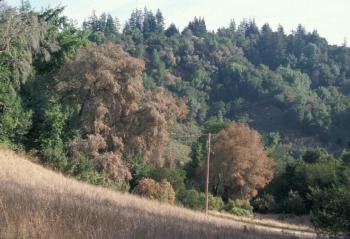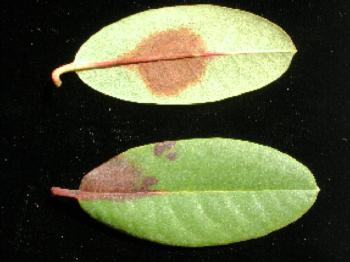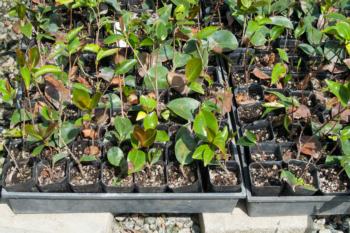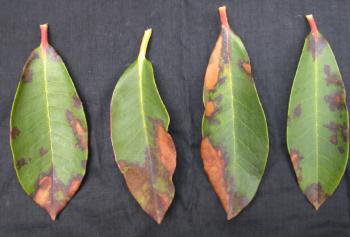Spring 2015: Ramorum blight and how to keep it out of your nursery
Regional Report for Santa Cruz and Monterey Counties by Steve Tjosvold
Phytophthora ramorum, an introduced plant pathogen, has killed thousands of native oaks in coastal areas of California and Oregon where the disease is known as sudden oak death (fig. 1). The pathogen also can infect leaves, stems and roots on many common nursery crops; the resulting disease is often called Ramorum blight. Although the disease is usually not serious on ornamental crops, there is concern that the pathogen could be moved inadvertently on nursery stock to new areas and eventually infect new landscape and forest hosts. There are federal and state quarantines that require inspections for nursery stock in regulated California counties. If the pathogen is detected, the affected plants are destroyed and the pathogen is eradicated.

Fig. 1. Sudden Oak Death, the disease causing mortality on California coast live oak in 1999. Photo: S. Tjosvold
Although hosts of P. ramorum show a range of symptoms, in general, the disease is characterized by irregular necrotic leaf lesions, rather than distinct leaf spots. Leaf infections can develop down the petiole and into twigs (fig. 2). Often, such as in camellia, infected leaves fall off before the lesion reaches the petiole. Infections may occur initially on stems or move into stems and cause blights in which stems and associated leaves wilt, become necrotic and die (fig. 3). A distinct dark line can mark the advance of the infection on some host species. Root infections are difficult to detect because root symptoms are usually not expressed. However, these asymptomatic infections are capable of producing infectious spores. Under wet and cool conditions, infectious spores can be produced on leaves and move in water runoff during irrigation or rain events. Even nearby streams and ponds may become contaminated with P. ramorum. Soil in containers or in the field can be infested with long-lived chlamydospores and mycelium in plant debris and fallen leaves.

Fig. 2. Rhododendron leaf symptoms. Irregular lesions can coalesce and sometimes develop into leaf veins or petiole. Photo: S. Tjosvold

Fig. 3. Camellia liners with leaf lesions and defoliation caused by P. ramorum. Photo: S. Tjosvold
Five genera of ornamental hosts have accounted for most of the P. ramorum official detections in nurseries: Rhododendron, Camellia, Pieris, Kalmia and Viburnum (fig. 4). However, P. ramorum has a wide host range, and other hosts could be important carriers of the pathogen in the nursery trade. For the complete list of known hosts, see the currently identified hosts by USDA APHIS: (http://www.aphis.usda.gov/plant_health/plant_pest_info/pram/downloads/pdf_files/DA-2013-41.pdf).

Fig. 4. Viburnum leaf symptoms. Irregular lesions with dark banding at the edge of the lesions. Photo: C. Blomquist, CDFA.
Management of this disease begins with preventing it from being introduced into the nursery. First, make sure you are buying propagation plant material or other plants from trusted suppliers. The California Department of Food and Agriculture maintains lists of California suppliers that are inspected and approved to ship nursery stock. See: http://www.cdfa.ca.gov/plant/PE/InteriorExclusion/SuddenOakDeath/index.html. For high-risk incoming shipments, unload nursery stock in an area of the nursery that can be cleaned of leafy debris. Sweep debris from the receiving area and delivery truck and bag for disposal. Loading and delivery areas should be isolated from production areas. Infected leafy debris can be blown into production areas by the wind.
Symptoms on plants introduced to the nursery are not always readily apparent at first. These plants can be isolated away from normal production areas and systematically monitored for symptoms about once a week for several weeks. Symptoms of many nursery hosts can be found at the website given below. Field diagnostic kits from Agdia (Elkart, IN) or Neogen (Lansing, MI) can aid in detecting Phytophthora species. These Phytophthora kits do not detect specific species, but can detect numerous Phytophthora species including P. ramorum. See Spring 2015: Pathogen field test kits
In general, the same cultural management practices that help control other Phytophthora species will also help control the introduction and spread of P. ramorum. Start with clean planting mix that drains well, use clean containers, and keep nursery stock on a gravel bed or use another method to avoid container contact with field soil. Avoid overwatering or underwatering and other plant stresses. Avoid irrigation practices that wet the foliage for prolonged periods. If sprinklers are used, irrigate in the morning to allow for thorough and quick drying of foliage. Good plant spacing helps dry foliage.
The same fungicides that are active on other Phytophthora species can also help prevent infection by P. ramorum. Most conventional Phytophthora fungicides are applied as a soil drench and may prevent root infections by P. ramorum. A few fungicides applied to the soil move somewhat upward in the plant and may protect the foliage against infection. The best way to protect foliage, however, would be to spray fungicides directly on the foliage, but the fungicide needs to be registered for this type of application. Fungicides active on Phytophthora should not be applied to introduced nursery stock or cuttings that are being monitored for P. ramorum infection because detection of symptoms may be delayed or masked.
If nurseries are located where sudden oak death is found, periodically inspect nearby native hosts for disease symptoms. Infected California bay trees (Umbellularia californica) near the perimeter of nurseries may produce inoculum that can spread and infect nearby host plants. Removal of these trees may be warranted. Rain runoff coming down slope from areas containing infected hosts may contain P. ramorum. Consider building berms to prevent water and soil from hillsides surrounding the nursery from moving into production areas. Irrigation water pumped from streams and ponds may be contaminated with P. ramorum. Consider using alternative irrigation sources, such as well water, or employ water disinfection treatments.
There is an excellent website to obtain more information about sudden oak death, as well as nursery management practices and guides for P. ramorum. The website is actively maintained by the California Oak Mortality Task Force: http://www.suddenoakdeath.org/
Steven A. Tjosvold
Farm Advisor, Environmental Horticulture
UC Cooperative Extension Santa Cruz County
1432 Freedom Boulevard
Watsonville, CA 95076-2796
(831)763-8013 phone, (831) 763-8006 fax
satjosvold@ucanr.edu
http://cesantacruz.ucanr.edu/












